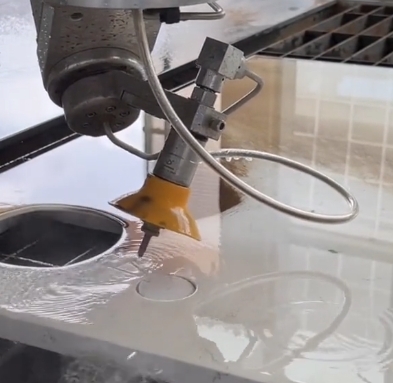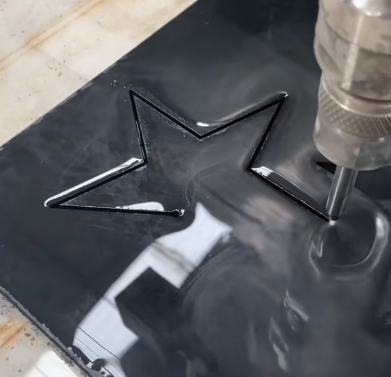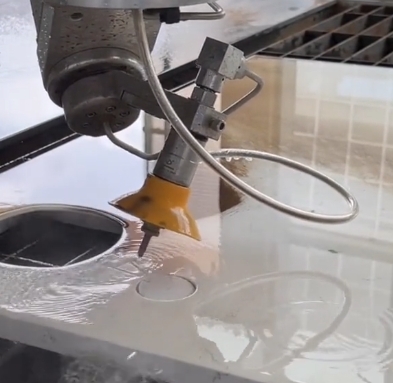Precision-cutting technology plays a vital role in modern manufacturing. Water jet cutting and laser cutting are the two most popular technologies. Although they both provide high-precision cutting results, there are significant differences in application fields, cutting capabilities, costs, etc. This article compares the two cutting technologies, discusses their advantages and disadvantages, and helps readers choose the best option for different applications.

Water cutting technology and laser-cutting definition
Water cutting, also known as water jet cutting, is a process that uses high-pressure water flow to cut materials. A high-velocity water jet is created by pressurizing water to 30,000–90,000 psi and spraying it through a small hole. This jet can cut soft materials like rubber, textiles, and food. For hard materials such as metal, glass, and stone, abrasive materials (like garnet or stone sand) are added to improve cutting performance.
Laser cutting is a technology that uses a highly concentrated, high-energy-density laser beam emitted by a laser to cut materials. This method enables high-precision cutting of various materials, including metal, plastic, wood, paper, and textiles. Laser cutting technology is often combined with a computer numerical control (CNC) system, allowing the cutting process to be automated and precisely controlled.
Is laser cutting more expensive than waterjet cutting?
Laser cutting equipment uses high-power lasers and precision optical systems. These systems have a much higher acquisition cost than waterjet cutting systems. Additionally, laser equipment requires significant maintenance and consumes more power, raising overall operating costs. However, laser cutting is ideal for mass production due to its fast cutting speed and high efficiency, allowing more tasks to be completed in less time.
In contrast, waterjet cutting requires a lower initial investment but has high operating costs. It uses high-pressure pumps, large volumes of water, and often abrasive materials like garnet sand, all of which increase long-term operating expenses.

Similarities between laser cutting and waterjet cutting
1. Complex shape cutting
- Laser Cutting: Laser cutting is commonly used to cut precision metal parts, like complex components in the aerospace industry. It can cut intricate shapes, ensuring smooth, precise edges for parts like aircraft fuselages and engine components.
- Waterjet Cutting: Waterjet cutting handles complex shapes, especially in stone and glass processing. It is widely used for cutting artistic patterns in marble floors or custom shapes for glass curtain walls.
2. High-precision processing
- Laser cutting: used to manufacture precision electronic devices such as mobile phone casings and circuit boards. Laser cutting can handle cut widths as small as a few millimeters, ensuring high precision and consistency of equipment parts.
- Waterjet cutting: It also shows its high-precision advantages in medical device manufacturing. Waterjet cutting maintains the accuracy and dimensional stability of precision medical device parts, such as surgical blades and diagnostic tools.
3.Suitable for a variety of materials
- Laser cutting: widely used for cutting plastic, wood, and metal. For example, laser cutting is used to produce advertising signs and decorative arts. It can quickly process a variety of materials and cut exquisite patterns according to design requirements.
- Waterjet cutting: can also cut a variety of materials, such as frozen meat used in the food industry. It cuts food without applying heat, preserving its original quality and shape.

How water cutting works
- Generation of High-Pressure Water Fl: Water cutting uses a high-pressure pump to pressurize water to 30,000 to 90,000 psi, creating high-pressure water flow. For hard materials, abrasive materials like garnet sand are added to enhance cutting.
- Nozzles and Cutting: The high-pressure water jet exits small nozzles, forming high-speed water jets. These jets focus on the material surface, cutting it gradually. Abrasive materials enhance cutting, breaking down the material through grinding.
- Cooling and Removal: During cutting, water cools the material and removes molten or broken parts. This reduces thermal impact and minimizes material deformation.
How laser cutting works
- Laser Generation: Laser cutting uses a laser to create a highly concentrated beam. It excites a laser medium (gas, solid, or liquid) to produce high-energy beams of specific wavelengths.
- Laser Beam Focusing: An optical system (such as a lens) focuses the laser onto the material’s surface, creating a small, high-energy light spot. This rapidly heats the material to a molten or vaporized state.
- Material Cutting: The laser beam moves along a set path to cut the material by melting or vaporizing it. Auxiliary gases (like oxygen or nitrogen) blow away molten material, increasing speed and quality.
- Thermal Impact: Laser cutting generates a heat-affected zone. The material in the laser irradiation area heats and melts, possibly causing thermal deformation or damage.

The difference between water cutting and laser cutting
Waterjet and laser cutting differ significantly in process principles and applications. Water cutting uses high-pressure water (with or without additives) to cut materials, relying on the impact of water flow to shape the material. Laser cutting uses a high-energy laser beam to melt or vaporize the material. These differences lead to varying applications and cutting effects.
Water cutting can process almost any material, including metal, stone, glass, and composites. Laser cutting mainly works with metals, plastics, and some non-metals. Waterjet cutting excels with heat-sensitive materials, while laser cutting is more efficient for metals.
Water cutting is suitable for thicker materials (up to several inches) but is slower. Laser cutting is faster and better suited for thin materials (usually under 1 inch), especially in large-scale production. Laser cutting provides higher accuracy, but it may create heat-affected zones. Water cutting avoids thermal effects and maintains material stability.
In terms of cost, laser cutting requires a higher initial investment but has lower long-term operating costsWater-cutting equipment is cheaper upfront but has higher operating costs, particularly for consumables and maintenance. The choice between technologies depends on factors like material type, thickness, budget, and production efficiency.

conclusion
Waterjet cutting and laser cutting each have their advantages and disadvantages. Choosing the right technology depends on factors like application, material properties, efficiency, and cost. Waterjet cutting excels at processing thick and heat-sensitive materials. Laser cutting offers speed and precision, making it ideal for high-volume and high-precision tasks. Both technologies will continue to evolve and play key roles in future manufacturing.
